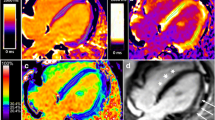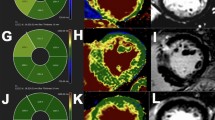Abstract
The purpose of this study was to establish an MRI protocol on a clinical scanner for assessment of left (LV) and right (RV) ventricular myocardial function of the murine heart, and to apply this protocol for the first in vivo assessment of myocardial function in a mouse model of cardiomyopathy (Desmin−/−). MRI was performed on a clinical 3 T whole body MRI system using a dedicated solenoid receive-only coil. Contiguous short axis slices were acquired covering the entire heart using a spoiled cine gradient echo sequence (TR 9–12 ms, TE 3–4 ms, α 25°, 1.0 × 0.23 × 0.23 mm³). Global LV- and RV-myocardial functional parameters such as end-diastolic ventricular volume, ejection fraction (EF), LV mass and cardiac output (CO) of Desmin−/− mice and age-matched controls were determined. Global myocardial functional data of healthy controls (n = 4) were in very good agreement with previously reported data. The transgenic mice (n = 8) revealed a significantly reduced LV- and RV-EF as well as CO. Body weight-normalized LV- and RV-end-diastolic volumes and LV mass were significantly increased. In addition desmin deficient mice exhibited segmental wall thinning and akinesia, suggesting myocardial necrosis. This study demonstrates that clinical 3 T MRI-systems may reliably be used for non-invasive assessment of LV- and RV-myocardial function in normal and in genetically engineered mice with cardiomyopathies. In addition, this proof of principle study presents first in vivo MRI data of the cardiac phenotype of desmin knock-out mice.




Similar content being viewed by others
References
Epstein FH (2007) MR in mouse models of cardiac disease. NMR Biomed 20:238–255
Bunck AC, Engelen MA, Schnackenburg B, Furkert J, Bremer C, Heindel W et al (2009) Feasibility of functional cardiac MR imaging in mice using a clinical 3Tesla whole body scanner. Invest Radiol 44:749–756
Agbulut O, Li Z, Mouly V, Butler-Browne GS (1996) Analysis of skeletal and cardiac muscle from desmin knock-out and normal mice by high resolution separation of myosin heavy-chain isoforms. Biol Cell 88:131–135
Balogh J, Merisckay M, Li Z, Paulin D, Arner A (2002) Hearts from mice lacking desmin have a myopathy with impaired active force generation and unaltered wall compliance. Cardiovasc Res 53:439–450
Li Z, Colucci-Guyon E, Pincon-Raymond M, Mericskay M, Pournin S, Paulin D et al (1996) Cardiovascular lesions and skeletal myopathy in mice lacking desmin. Dev Biol 175:362–366
Milner DJ, Taffet GE, Wang X, Pham T, Tamura T, Hartley C et al (1999) The absence of desmin leads to cardiomyocyte hypertrophy and cardiac dilation with compromised systolic function. J Mol Cell Cardiol 31:2063–2076
Milner DJ, Weitzer G, Tran D, Bradley A, Capetanaki Y (1996) Disruption of muscle architecture and myocardial degeneration in mice lacking desmin. J Cell Biol 134:1255–1270
Thornell L, Carlsson L, Li Z, Mericskay M, Paulin D (1997) Null mutation in the desmin gene gives rise to a cardiomyopathy. J Mol Cell Cardiol 29:2107–2124
Schrickel JW, Stockigt F, Krzyzak W, Paulin D, Li Z, Lubkemeier I et al (2010) Cardiac conduction disturbances and differential effects on atrial and ventricular electrophysiological properties in desmin deficient mice. J Interv Card Electrophysiol 28:71–80
Roth DM, Swaney JS, Dalton ND, Gilpin EA, Ross J Jr (2002) Impact of anesthesia on cardiac function during echocardiography in mice. Am J Physiol Heart Circ Physiol 282:H2134–H2140
Nahrendorf M, Wiesmann F, Hiller KH, Han H, Hu K, Waller C et al (2000) In vivo assessment of cardiac remodeling after myocardial infarction in rats by cine-magnetic resonance imaging. J Cardiovasc Magn Reson 2:171–180
Cerqueira MD, Weissman NJ, Dilsizian V, Jacobs AK, Kaul S, Laskey WK et al (2002) Standardized myocardial segmentation and nomenclature for tomographic imaging of the heart a statement for healthcare professionals from the Cardiac Imaging Committee of the Council on Clinical Cardiology of the American Heart Association. Int J Cardiovasc Imaging 18:539–542
Manning WJ, Wei JY, Katz SE, Litwin SE, Douglas PS (1994) In vivo assessment of LV mass in mice using high-frequency cardiac ultrasound: necropsy validation. Am J Physiol 266:H1672–H1675
Franco F, Thomas GD, Giroir B, Bryant D, Bullock MC, Chwialkowski MC et al (1999) Magnetic resonance imaging and invasive evaluation of development of heart failure in transgenic mice with myocardial expression of tumor necrosis factor-alpha. Circulation 99:448–454
Daire JL, Jacob JP, Hyacinthe JN, Croisille P, Montet-Abou K, Richter S et al (2008) Cine and tagged cardiovascular magnetic resonance imaging in normal rat at 1.5 T: a rest and stress study. J Cardiovasc Magn Reson 10
Schneider JE, Wiesmann F, Lygate CA, Neubauer S (2006) How to perform an accurate assessment of cardiac function in mice using high-resolution magnetic resonance imaging. J Cardiovasc Magn Reson 8:693–701
Zhou R, Pickup S, Glickson JD, Scott CH, Ferrari VA (2003) Assessment of global and regional myocardial function in the mouse using cine and tagged MRI. Magn Reson Med 49:760–764
Wiesmann F, Ruff J, Hiller KH, Rommel E, Haase A, Neubauer S (2000) Developmental changes of cardiac function and mass assessed with MRI in neonatal, juvenile, and adult mice. Am J Physiol Heart Circ Physiol 278:H652–H657
Wiesmann F, Frydrychowicz A, Rautenberg J, Illinger R, Rommel E, Haase A et al (2002) Analysis of right ventricular function in healthy mice and a murine model of heart failure by in vivo MRI. Am J Physiol Heart Circ Physiol 283:H1065–H1071
Liu G, Iden JB, Kovithavongs K, Gulamhusein R, Duff HJ, Kavanagh KM (2004) In vivo temporal and spatial distribution of depolarization and repolarization and the illusive murine T wave. J Physiol-Lond 555:267–279
Strach K, Sommer T, Grohe C, Meyer C, Fischer D, Walter MC et al (2008) Clinical, genetic, and cardiac magnetic resonance imaging findings in primary desminopathies. Neuromuscul Disord 18:475–482
He Y, Zhang Z, Hong D, Dai Q, Jiang T (2010) Myocardial fibrosis in desmin-related hypertrophic cardiomyopathy. J Cardiovasc Magn Reson 12:68
Conflict of interest
None.
Author information
Authors and Affiliations
Corresponding author
Rights and permissions
About this article
Cite this article
Sprinkart, A.M., Block, W., Träber, F. et al. Characterization of the failing murine heart in a desmin knock-out model using a clinical 3 T MRI scanner. Int J Cardiovasc Imaging 28, 1699–1705 (2012). https://doi.org/10.1007/s10554-011-9990-3
Received:
Accepted:
Published:
Issue Date:
DOI: https://doi.org/10.1007/s10554-011-9990-3




